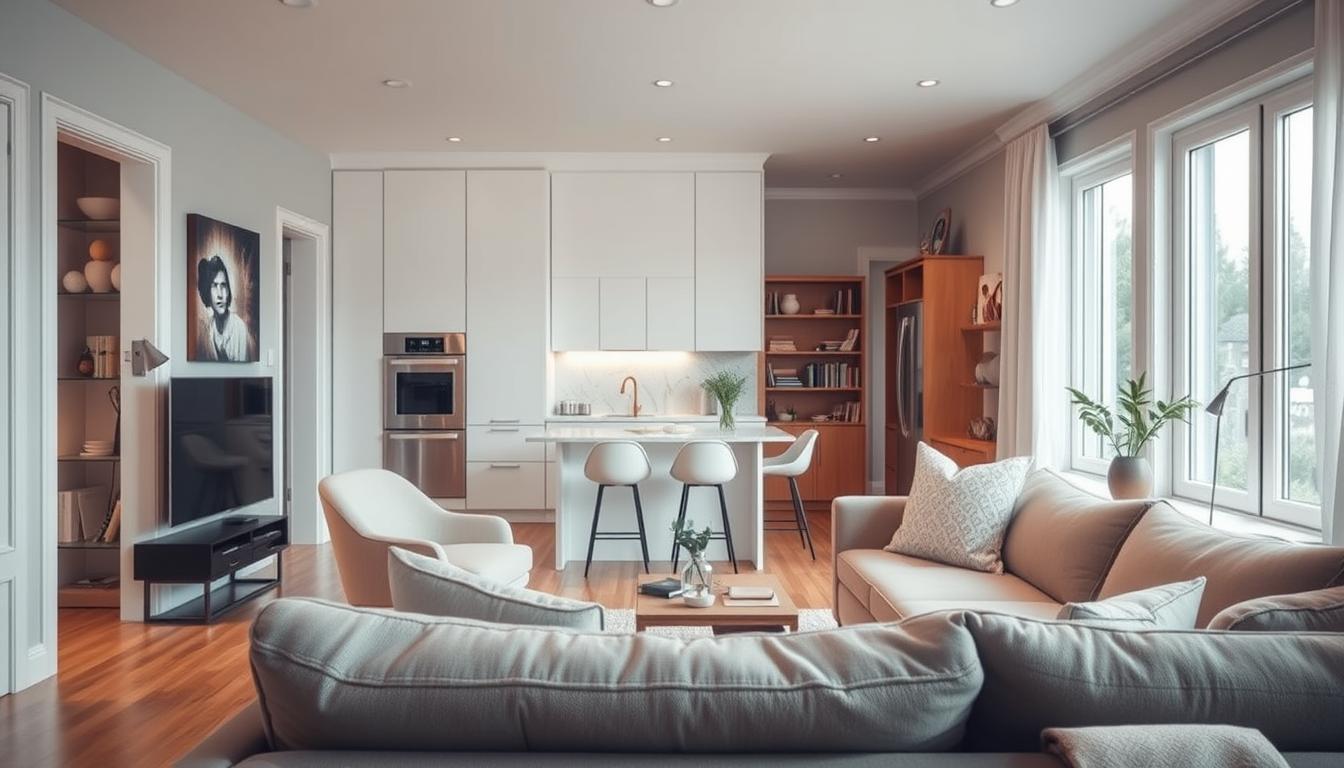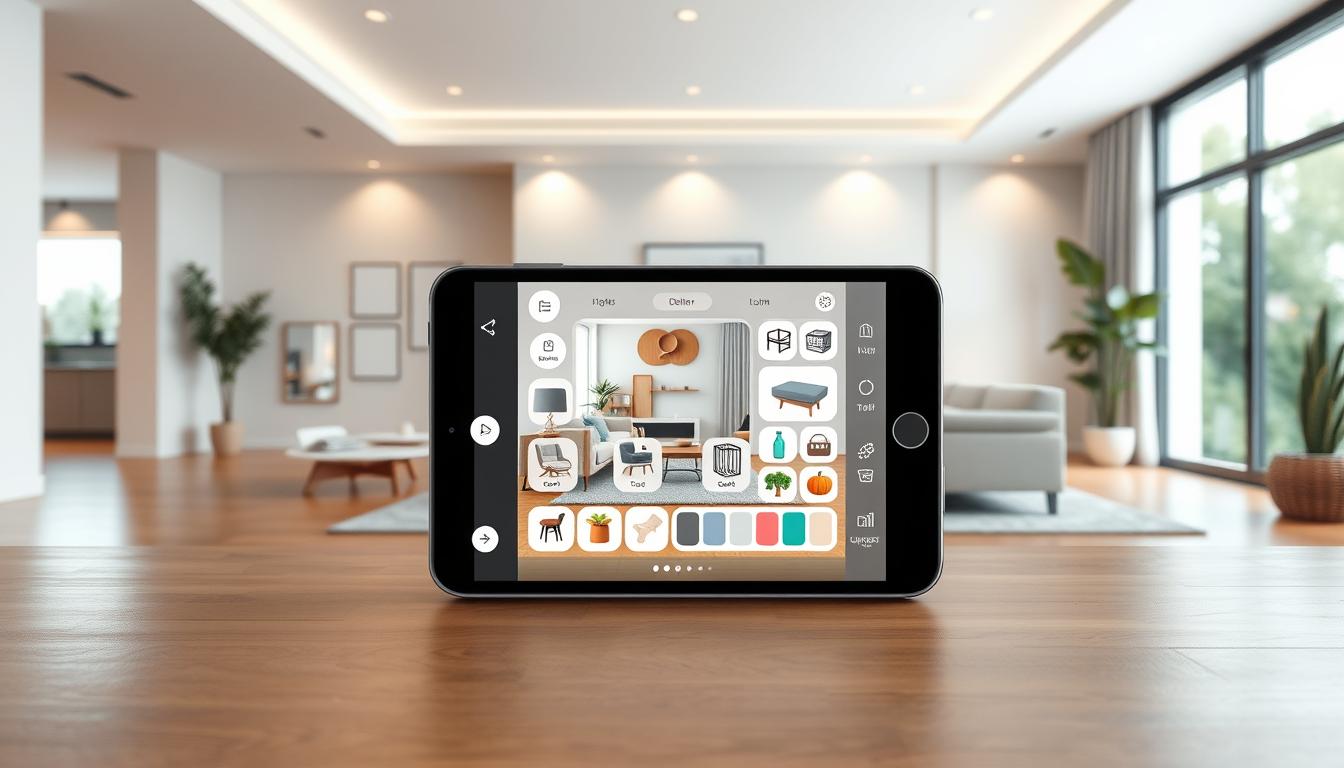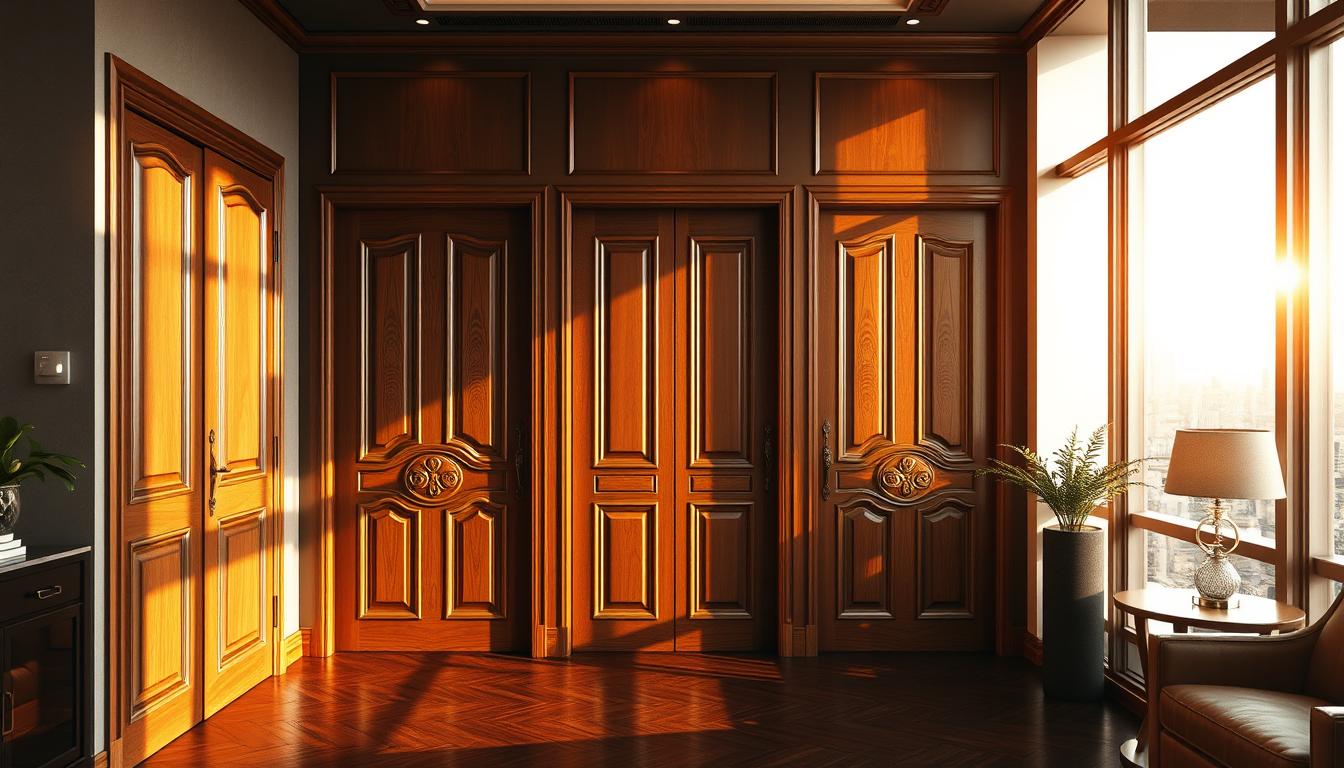Did you know over 40% of U.S. households live in small homes? This shows the need for small house interior ideas that make the most of space. At Luxe Interior Co, we get the challenge of designing small spaces.
Creating a small house needs careful planning to mix function and beauty. With smart design choices, you can make a cozy, inviting space that feels big and open.
Key Takeaways
- Optimize furniture for multi-functionality
- Utilize vertical space for storage
- Select a cohesive color palette
- Minimize clutter with smart decor
- Leverage natural light to enhance ambiance
Understanding Small Space Challenges
To make a small space welcoming and useful, you need to know the common problems. Small homes and apartments can be cozy but also tricky. You must design carefully.
Common Issues in Small Homes
Small homes struggle with little storage, clutter, and hard layouts. These problems make it tough to design a space that looks and works well. Let’s look at some common issues:
- Limited storage capacity
- Cluttered living areas
- Difficulty in defining different zones within the space
Fixing these problems is key to a cozy and useful living area.
Importance of Functionality
Functionality is vital in small space design. It’s not just about looks; it’s about making the space work for you. A good design makes the space feel bigger and more comfy.
To be functional, think about these:
| Design Element | Functional Benefit |
|---|---|
| Multi-functional furniture | Serves more than one purpose, reducing clutter |
| Efficient storage solutions | Keeps belongings organized and out of the way |
| Clear pathways | Enhances flow and makes the space feel larger |
Balancing Aesthetics and Utility
It’s important to balance looks and use in small spaces. The space should look good and meet your needs. Mixing stylish and practical elements creates a welcoming and useful space.
For example, picking furniture that’s both stylish and useful helps. Also, adding decor that serves a purpose improves the design.
By understanding small space challenges and focusing on both looks and use, you can make a beautiful and functional living area.
Maximizing Natural Light
Natural light can make a small home feel bigger and more welcoming. It not only makes our homes look better but also works better.
Choosing the Right Window Treatments
The right window treatments are key to letting in natural light. Sheer curtains or blinds are great because they let light in while keeping things private. Heavy drapes, on the other hand, block light and make spaces feel tight.
For the best light, pick light-colored window treatments that bounce light around. This simple choice can make your home feel much brighter and more inviting.
Utilizing Mirrors to Reflect Light
Mirrors are smart for adding light to small homes. By putting mirrors where they reflect natural light, we make rooms feel brighter and bigger. This trick not only brightens the mood but also makes spaces seem larger.
- Place a large mirror opposite a window to reflect natural light.
- Use mirrored furniture or decorative mirrors to add more reflective surfaces.
- Consider a mirrored wall or a mirrored closet door for maximum effect.
Light Color Schemes for Walls
The color of your walls affects how light or dark a room feels. Light colors on walls make rooms feel more open and airy. White, cream, or light gray are perfect for small homes because they reflect light and make spaces feel bigger.
Avoid dark colors that soak up light and make rooms feel cramped. If you want some color, choose soft pastel shades. They add personality without overwhelming the space.
Smart Furniture Choices
In small spaces, picking the right furniture is crucial. It helps make rooms feel bigger, more comfy, and useful. We’ll look at how to pick furniture that fits these needs.
Multi-Functional Furniture Ideas
Using multi-functional furniture is a smart move for small spaces. Items like storage ottomans or sofa beds do more than one thing. They cut down on clutter and make the space more useful.
For example, a coffee table with storage can hold books and magazines. This keeps them out of sight but still accessible.
Another great idea is a desk with built-in shelves. It keeps your home office tidy. When picking multi-functional furniture, think about what your space needs and how different items can help.
Choosing Compact Pieces
Compact furniture fits well in small spaces without losing style or comfort. Look for sofas and chairs that take up less room. Also, consider nesting tables that can be hidden away when not needed.
When buying compact furniture, measure your space well. This ensures the pieces fit right. It’s also smart to try furniture out in person to see how it looks and feels.
Lightweight Options for Flexibility
Lightweight furniture makes your small space more flexible. It’s easier to move or change things around. Look for chairs, tables, and other items made from light materials.
- Think about foldable furniture, like folding chairs or drop-leaf tables, for easy storage.
- Choose furniture with casters or wheels for easy moving.
- Go for materials like aluminum or lightweight woods for durability and ease of moving.
Color Schemes that Work Wonders
Maximizing small spaces means choosing the right colors. The right colors can make a tiny house feel bigger and more welcoming.
Light Colors to Open Up Spaces
Light colors on walls and ceilings can make a room look bigger. White, cream, and pale gray reflect light, making spaces feel larger.
- Soft whites and creams for a clean and airy feel
- Pale grays and blues to add a touch of coolness
- Pastel shades for a subtle pop of color
Accent Walls for Depth
Light colors make a room feel bigger, but accent walls add depth. A bold, contrasting color on one wall creates a focal point and adds interest.
Tips for accent walls:
- Select a color that complements the overall palette
- Consider the room’s natural lighting when choosing a color
- Use accent walls to draw attention to a particular feature or area
Harmonizing Color Palettes
A well-coordinated color palette is key for small spaces. Choosing a few core colors and using them everywhere creates a cohesive and calming atmosphere.
To get a harmonious palette, use the 60-30-10 rule. 60% of a dominant color, 30% of a secondary color, and 10% of an accent color. This balance makes for a visually appealing and peaceful space.
Effective Space Planning
In small homes, the right space planning is key. It’s not just about fitting everything in. It’s about making a space that’s both functional and comfortable.
Creating Zones in Open Areas
Open-plan living areas in small homes can be a challenge. To make the most of this space, we need to create distinct zones for different activities. This can be done by strategically placing furniture, rugs, and other decorative elements.
- Use area rugs to define different zones within an open-plan space.
- Place furniture in a way that creates natural pathways and separates areas.
- Consider using room dividers or screens to create more defined spaces.
Furniture Layout Tips for Flow
The layout of furniture is crucial for maintaining a smooth flow in small homes. We should aim to create a path that is easy to navigate, avoiding clutter and narrow passageways.
Tips for Furniture Layout:
| Tip | Description | Benefit |
|---|---|---|
| Keep pathways clear | Avoid placing furniture in a way that blocks the natural flow. | Enhances navigation and reduces clutter. |
| Use multi-functional furniture | Choose furniture that serves more than one purpose. | Saves space and increases functionality. |
| Scale furniture appropriately | Select furniture that is proportionate to the size of the room. | Creates a balanced and harmonious space. |
Visual Tricks for Perception
Visual tricks can make a room feel more spacious. By using certain design elements, we can create the illusion of more space.
- Use mirrors to reflect light and create the illusion of more space.
- Choose light colors for walls and floors to make the room feel larger.
- Minimize clutter and keep surfaces clear to maintain a sense of openness.
By using these strategies, we can make our small homes feel more spacious, functional, and comfortable.
Emphasizing Vertical Space
Maximizing vertical space is key to making small homes feel open. By using a room’s height, homeowners can improve both the look and use of tight spaces.
Tall Shelving for Storage
Tall shelving units are great for using vertical space. They offer lots of storage for books, decorations, and kitchen items. They also make the room feel taller by pulling the eye up. Look for compact home interior solutions that are both useful and good-looking.
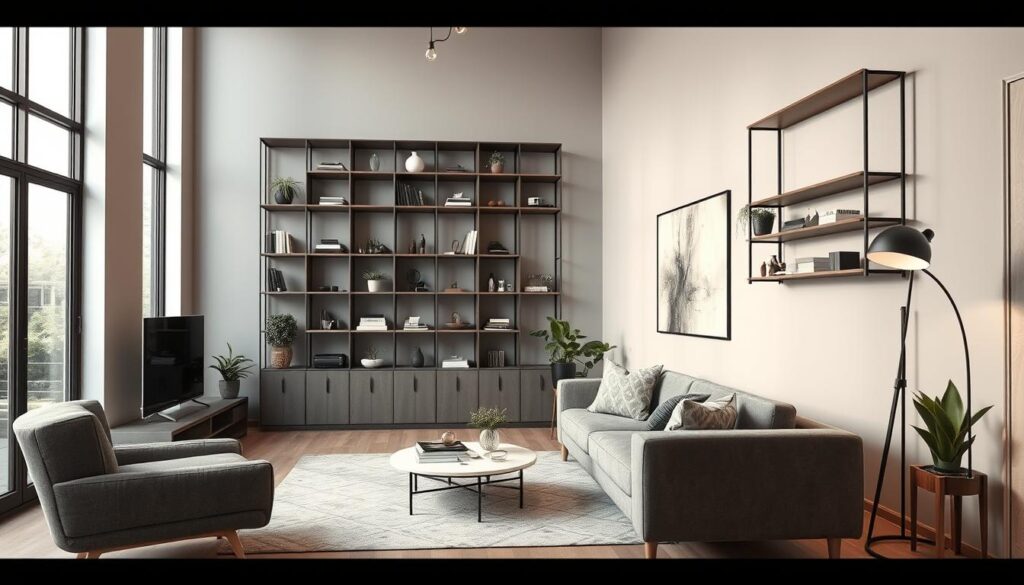
Hanging Decor to Free Floor Space
Hanging decor is another smart way to use vertical space. Hanging items like plants, lights, or decorations from the ceiling saves floor space. This makes the area feel bigger and less crowded. It’s very helpful in cozy interior design for small homes, where every inch matters.
Utilizing High Ceilings
High ceilings offer a chance to make a big design statement. Using vertical space in these areas can mean installing curtains from floor to ceiling, using tall vases, or even vertical gardens. These features not only use the height but also add elegance and style.
By using these ideas, homeowners can make their living spaces more open, useful, and attractive. Focusing on vertical space is a simple yet powerful way to improve small homes. It makes them feel more spacious and welcoming.
Storage Solutions for Small Areas
In small spaces, smart storage can really help. It keeps things tidy and makes your home more useful.
Creative Storage Ideas
Maximizing storage in small homes is easy with creative ideas. Stackable containers or baskets keep things organized and hidden. Ottomans with storage are also great, as they serve as both a seat and a place to store things.
Installing shelves or storage units that reach the ceiling is another smart move. It boosts storage without using too much floor space. This keeps the floor clear and makes the room feel taller.
Hidden Storage Options
Hidden storage is key in small homes, keeping things neat. Under-bed storage is perfect for linens, out-of-season clothes, or luggage. Storage beds or bed frames with drawers are also effective.
Decorative items that also store things are another smart choice. Storage cubes or baskets can be placed on shelves or in corners. They’re both useful and add to the room’s look.
Utilizing Under-Furniture Space
Using space under furniture is a smart way to add storage. Bed risers or storage bins under the bed offer plenty of room for less-used items.
In living rooms, furniture with built-in storage is a big help. Coffee tables with storage or sofas with hidden spots keep clutter away. This makes the space more organized and peaceful.
By using these storage solutions, homes can be more organized and feel bigger. It’s important to try out different options to find what works best for your home and style.
Personalizing Your Decor
Making a small house feel like home is all about personalizing your decor. It’s about showing off your personality, interests, and style. In small homes, every detail matters, and personal touches can make a big difference.
Incorporating Personal Touches
Adding personal touches to your home is easy. Displaying family photos, heirlooms, or collectibles can add character. Using personal items as decor makes your home feel warm and welcoming.
Creating a gallery wall with frames that match your home’s colors is a great idea. It’s a way to show off cherished memories and add interest to your walls. You can also use throw pillows, blankets, and rugs that show off your style.
Art and Accessories Selection
Choosing the right art and accessories is key to a great tiny house interior design. Artwork can bring color, texture, and personality to your walls. Abstract art can add a dynamic touch, while black and white photography can bring calm and sophistication.
Accessories like vases, sculptures, or decorative objects can also make your space unique. Look for items with a story or sentimental value. For example, a vase passed down through generations can be a beautiful and meaningful piece.
| Accessory Type | Personalization Idea | Benefit |
|---|---|---|
| Family Photos | Create a gallery wall | Adds warmth and character |
| Heirlooms | Display prominently | Creates a sense of history |
| Collectibles | Use decorative shelves | Sparks conversations |
Using Family Heirlooms Wisely
Family heirlooms can add a special touch to your home decor. They connect you to your heritage. Restoring or conserving them ensures they stay cherished for years.
“The way we decorate our homes is a reflection of who we are, and incorporating family heirlooms into our decor is a meaningful way to honor our heritage.”
To use family heirlooms well, think about where they’ll go. A vintage clock can be a great centerpiece, while antique linens can be decorative throws or table runners. This honors your family’s history and adds a unique touch to your home.
By adding personal touches, choosing meaningful art and accessories, and using family heirlooms wisely, you can make your home truly yours. Personalizing your decor is about showing off your personality and style.
Indoor Plants for Freshness
Indoor plants can make small living areas feel alive and vibrant. They not only make your home look better but also improve the air quality. This makes your living space healthier.
Best Plants for Small Spaces
Choosing the right plants for small homes is key. Look for ones that are compact or can grow well in low light. Here are some great picks:
- Snake Plant: It purifies the air and grows well in little light.
- ZZ Plant: It’s easy to care for and can handle neglect, perfect for busy people.
- Pothos: It’s versatile and simple to care for, great for hanging or trailing.
- Dracaena: It adapts to different lights and can grow tall, ideal for corners.
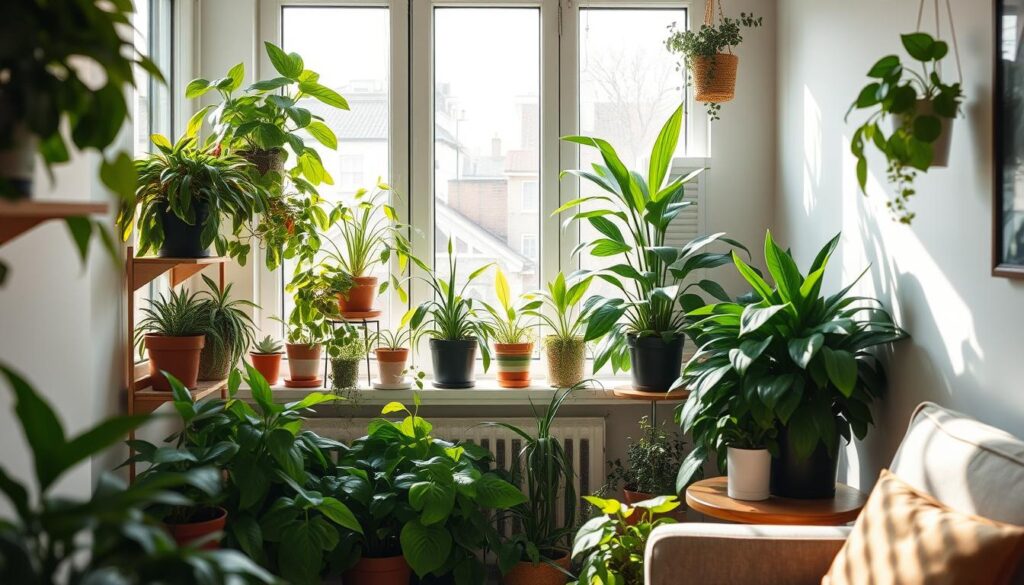
Placement Tips for Greenery
Where you put your plants matters a lot. Here are some tips:
- Put plants where they get the right light for them.
- Use hanging planters or wall pots to save floor space.
- Group plants together for a mini garden look.
- Put plants in corners or against walls to use space better.
Maintenance of Indoor Plants
Keeping your plants healthy needs regular care. Here’s how:
- Watering: Check soil moisture and water right. Don’t overwater.
- Fertilization: Use a balanced fertilizer when plants are growing.
- Pruning: Prune plants to keep them looking good and growing well.
- Repotting: Move plants to bigger pots when their roots need more room.
By following these tips, you can enjoy the benefits of indoor plants in your small home. They will make your space cozier and fresher.
Optimizing Entryways
The entryway is key in small homes, setting the home’s tone. A good entryway makes a great first impression. It also lets you use space-saving designs.
Think about functionality, looks, and personal touches for your entryway. This mix creates a warm, stylish space that shows your taste.
Smart Hooks and Racks
Smart hooks and racks are great for entryways. They keep things organized and look good too.
- Install hooks for hanging coats, bags, and accessories.
- Use a rack for storing keys, mail, and other small items.
- Consider a wall-mounted rack to save floor space.
Interior design expert says, “Hooks and racks are not just useful; they can also be stylish in your entryway.”
“The right hooks and racks can turn your entryway from messy to modern.”
Stylish Shoe Storage
Shoe storage is vital in entryway design. Here are some chic options:
| Shoe Storage Option | Description | Space-Saving Benefit |
|---|---|---|
| Shoe Rack | A compact rack that holds multiple pairs of shoes. | Keeps shoes organized and off the floor. |
| Shoe Cubby | A cubby designed for shoe storage. | Offers a special spot for shoes. |
| Over-the-Door Shoe Organizer | A hanging organizer for shoes over the door. | Uses door space well and keeps shoes easy to reach. |
Creating a Welcoming Atmosphere
To make your entryway inviting, add personal touches like artwork, plants, or a unique piece of furniture.
Nate Berkus said, “The entryway is the first thing people see, so make it memorable.” Use smart storage, stylish decor, and personal touches. This way, your entryway welcomes guests and shows off your style.
Seasonal Updates and Flexibility
Decorating a small home is fun because you can easily change things with the seasons. This makes your space feel new and exciting all year without big changes.
Changing Decor with the Seasons
Just swapping out throw pillows, blankets, and other items can make a big difference. For example, use thick, warm fabrics in winter and light, cool ones in summer.
Seasonal Decor Ideas:
- Spring: Pastel colors, floral patterns, and fresh greenery
- Summer: Bright colors, nautical themes, and natural fibers
- Autumn: Warm tones, leaf patterns, and cozy textiles
- Winter: Rich jewel tones, snowflake motifs, and warm lighting
Seasonal Accessories and Textiles
Accessories and textiles are key for seasonal changes. Swapping out vases, decorative objects, and rugs can change your space’s look. Store away items not in season to keep your home tidy.
Rotating Artwork for Freshness
Changing your artwork seasonally is another great way to refresh your decor. This creates a new look in your home. Try making a schedule to keep your decor interesting and engaging.
Here’s a simple table to help plan your artwork rotation:
| Season | Artwork Theme | Color Palette |
|---|---|---|
| Spring | Floral, Nature | Pastels, Greens |
| Summer | Beach, Abstract | Brights, Neutrals |
| Autumn | Landscapes, Fall Themes | Warm Tones, Earthy |
| Winter | Snow, Winter Landscapes | Cold Tones, Rich Jewel Tones |
Conclusion: Bringing It All Together
Creating a great home interior in small houses needs creativity and a focus on details. By using the tips shared, you can make your small space cozy and welcoming.
Key Takeaways
We’ve looked at ways to use natural light, pick smart furniture, and save space. These tips help you balance looks and function in your small home.
Embracing Small Design
Cozy design in small homes is about using space well. With the right ideas, your small house can become a warm, inviting place that shows your style.
Final Considerations
As we wrap up, try out different design ideas to see what fits your small home best. This way, you’ll make your space more beautiful and useful.

